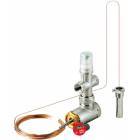Shut-off valves prevent the risk of cavitation
Cavitation is a harmful phenomenon that can affect valves operating in specific conditions, with the exception of shut-off valves

In the sectors using valves, critical situations very often occur that can damage the valves, at time very seriously. One of these conditions is called cavitation. This is responsible for the formation of air bubbles inside the valves, which then implode producing a characteristic noise. The cause lies in a local drop in pressure below the minimum value which corresponds to the vapour tension of the liquid. Implosion of the bubbles leads to an immediate surge in pressure, which can then cause even irreparable damage to the walls of the valves or pipelines.
To prevent this problem, shut-off valves are used, which operate according to a simple principle and avoid the effects of pressure drops on the shut-off valve itself. The valve can be used fully open or closed, without the option of mid-flow interception, thus avoiding zones where the speed of flow may increase to the point of creating negative pressure gradients. By operating in this way, the shut-off valve is the perfect solution where fluids must be conveyed without specific design requirements, thus limiting the risk of incurring in the damage described above.
To prevent this problem, shut-off valves are used, which operate according to a simple principle and avoid the effects of pressure drops on the shut-off valve itself. The valve can be used fully open or closed, without the option of mid-flow interception, thus avoiding zones where the speed of flow may increase to the point of creating negative pressure gradients. By operating in this way, the shut-off valve is the perfect solution where fluids must be conveyed without specific design requirements, thus limiting the risk of incurring in the damage described above.
23/10/2013
I contenuti di questo sito non hanno carattere di periodicità e non rappresentano 'prodotto editoriale'.








